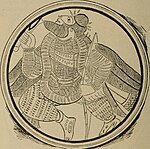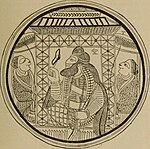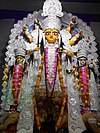
Dashabatar Cards (দশাবতার তাস) or Dashavatari Ganjifa are playing cards from West Bengal used to play certain games. They first originated in Bishnupur, a town in Bankura District. King Bir Hambir is attributed to the invention of these cards in the 16th century. The ten avatars of Bishnu are featured in the cards. It is a unique example of Bengal’s folk art.
Origin
In 1592, Bir Hambir became king of Bishnupur. He had a great relationship with Akbar, who had his own 12-suited pack of Ganjifa cards. During a visit to Akbar's court, Bir Hambur saw Akbar's cards and was inspired to create new and unique cards featuring the ten avatars of Bishnu. According to his directive, an artist from Bishnupur, Kartik Faujdar, created the first Dashabatar Cards. Kings of Mallabhum play with these cards at their leisure.

However, Indian scholar Hara Prasad Shastri believes that these cards originated earlier in the 8th century. His belief comes from two observations in a pack he was examining: Buddha being depicted with four arms, and Buddha having the lotus as his suit symbol. The first five avatars in Shastri's pack have four arms, and the latter five avatars have two arms, which helps to determine Buddha's placement as the fifth avatar. In common belief, Buddha (or Jagannath) is in the ninth position. This may be a clue as to when the cards originated, estimating some time when Buddha/Jagannath was still considered the fifth avatar. Furthermore, the lotus representing Buddha was a common emblem for when he was still known as Bodhisattva Padmapani during the reign of the Pala kings.
Prabhat Kumar Saha, an expert on Dashavatar cards, said: "Malla dynasty ruled from about 12th century AD to 1622". He confirmed that the Foujdars were the only makers of these cards in Bengal.
Sital Fouzdar claims to be the 87th generation of artisans. Nowadays, Vidyut Fouzdar makes them.
Method of manufacture
The artists from the Faujdar family of Bishnupur specialise in making these cards. First, three pieces of cloth are pasted together using glue made from tamarind seeds. After the glue dries, a layer of chalk dust is applied to the cards. Both sides are evened out with a smooth stone. The cards are then cut into circles with a 4.5-inch radius. Various deities and their suit symbols are painted on these cards using various colours. On the card backs, a layer of lac and vermillion is applied.
Cards

 Raja and Pradhan ranks from Parashurama suit
Raja and Pradhan ranks from Parashurama suit
Dashavatar cards feature ten suits and twelve ranks, with one of the ten avatars of Lord Vishnu on each suit. Similar to most other Ganjifa cards, the twelve ranks are made up of ten pip cards and two court cards, the King (called Raja) and Vizier (called Pradhan). Both court cards depict the same avatar for its suit, but one is differentiated by being enthroned in a sort of temple with attendants on either side. One possible ordering, suit symbols, and color backgrounds is as follows:
- Matsya (fish) black
- Kurma (tortoise) brown
- Baraha (conch) dark green
- Nrisingha (difficult to discern, flower or mace?) blue
- Baaman (round vessel) blue
- Parshuram (ax) white
- Ram (arrow) red
- Balaram or Krishna (pestle) green
- Buddha or Jagannath (lotus flower) yellow
- Kalki (sword) red
Another possible ordering, symbols, and colors is as follows:
- Matsya (fish) red
- Kurma (tortoise) red
- Baraha (boar) yellow
- Nrisingha (lion) green
- Baaman (round vessels) green
- Parshuram (ax) brown
- Ram (bow and arrow) yellow
- Balaram or Krishna (difficult to discern, yellow disk with red dot?) brown
- Buddha or Jagannath (conch shell) black
- Kalki (sword) black
A third order and symbols is as follows:
- Matsya (fish)
- Kurma (turtle)
- Baraha (boar)
- Nrisingha (lion, or half-man, half-lion)
- Buddha or Jagannath (conch shell)
- Baaman (round vessel)
- Ram (bow and arrow)
- Balaram or Krishna (round plate)
- Parshuram (ax)
- Kalki (sword)
The Dashavatar card game is a complicated one. It is played using 120 cards with numerous rules and regulations. It is played by three persons mainly in Sawantwadi in Maharashtra, India, although it is played by five persons in Bishnupur, West Bengal. It is considered the most popular Ganjifa set played throughout India, and depending on demand, this set may be extended up to 24 suits to encompass more major dieties like Brahma, Shiva, Ganesha, Kartikeya, Surya, Chandra, etc.
See also
Image gallery
-
 Artist making Dashavatara cards of Bishnupur
Artist making Dashavatara cards of Bishnupur
-
 Artist making Dashavatara cards of Bishnupur
Artist making Dashavatara cards of Bishnupur
-
 Artist making Dashavatara cards of Bishnupur
Artist making Dashavatara cards of Bishnupur
Notes
- the extra arms helps to identify which suits are in reverse order, which is a common feature in other early card games such as Tarot, Ombre, and Maw
References
- Singh, Shiv Sahay (5 December 2015). "Preserving Bishnupur's heritage". The Hindu. Retrieved 24 January 2018.
- "দশাবতার তাস, হারিয়ে যেতে বসা বাংলার এক শিল্প". Eenadu English Portal (in Bengali). Archived from the original on 2018-01-25. Retrieved 2018-01-24.
- ^ "Dashavatar Cards". Biswa Bangla. Retrieved 2018-01-24.
- ^ Das, Soumya; Das, Soumya (2015-02-05). "Dashavatar card-making faces extinction in Bengal". The Hindu. ISSN 0971-751X. Retrieved 2018-01-24.
- Manaranjan Chandra (2002). Mallabhum Bishnupur. Kolkata. p. 283.
{{cite book}}: CS1 maint: location missing publisher (link) - "Lost Game: Dashabatar Taas of Bishnupur - The Chitrolekha Journal on Art and Design". The Chitrolekha Journal on Art and Design. 2013-03-01. Retrieved 2018-01-24.
- Shastri, Hara Prasad (1895). "Vishnupur Circular Cards". Journal of the Asiatic Society of Bengal. LXIV.
I fully believe that the game was invented about eleven or twelve hundred years before the present date.
- "দশাবতার তাস – এক বিলুপ্তপ্রায় শিল্প ও এক বিলুপ্তপ্রায় খেলা". bandyopadhyaya.blogspot.in. 10 November 2015. Retrieved 2018-01-24.
- "Lost Game: Dashabatar Taas of Bishnupur – The Chitrolekha Journal on Art and Design". The Chitrolekha Journal on Art and Design. 2013-03-01. Retrieved 2018-01-24.
- ^ Culin, Robert Stewart (1898). Chess and Playing Cards. Washington. pp. 924–928. LCCN 16017551.
{{cite book}}: Check|archive-url=value (help) - Description based on booklet supplied with a set of cards from Sawantwadi Lacquerwares, The Palace, Sawantwadi 416510 Maharashtra, India.
- Pati, Arunima (June 11, 2020). "An Introduction to Ganjifa Cards". Indian Numismatic, Historical and Cultural Research Foundation. Retrieved June 20, 2024.
| Cuisine |  | ||||
|---|---|---|---|---|---|
| Dance |
| ||||
| Music |
| ||||
| Handlooms and handicrafts |
| ||||
| Observations and festivals | |||||
| Arts | |||||
| Other | |||||
| Playing card packs by geography | ||
|---|---|---|
| Historical patterns are shown in italics | ||
| Austria | Vienna |  |
| Austria - Germany | Vogelspiel | |
| Austria-Hungary | ||
| Belgium - Italy | Belgian-Genoese | |
| Bohemia | Bohemian (Prague) | |
| China | ||
| Denmark-Norway | Gnav | |
| France | ||
| Germany | ||
| India | ||
| Israel | Hamas most wanted | |
| Italy | ||
| Japan | ||
| Korea | Tujeon | |
| Southern Netherlands | Flemish Hunting Deck | |
| Persia | As-Nas | |
| Phillipines | Cádiz pattern | |
| Poland |
| |
| Russia | Russian | |
| Spain | ||
| Sweden | ||
| Switzerland | ||
| United States | ||
| Uruguay | ||
| Vietnam | ||
| Indonesia, Malaysia, Singapore, Thailand | Ceki | |